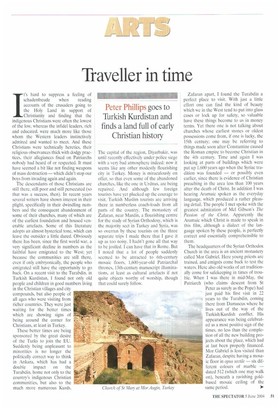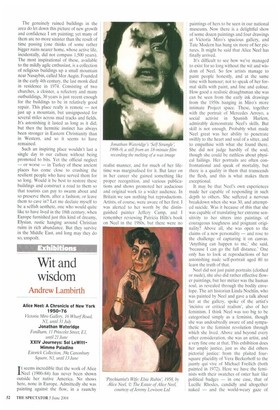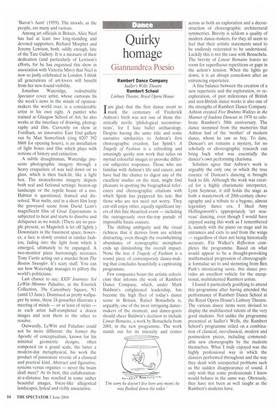Traveller in time
Peter Phillips goes to Turkish Kurdistan and finds a land full of early Christian history
It's hard to suppress a feeling of
schadenfreude when reading accounts of the crusaders going to the Holy Land in support of Christianity and finding that the indigenous Christians were often the lowest of the low, whereas the infidel leaders, rich and educated, were much more like those whom the Western leaders instinctively admired and wanted to meet. And these Christians were technically heretics, their religious observances thick with dodgy practices, their allegiances fixed on Patriarchs nobody had heard of or respected. It must have seemed a bit like not finding weapons of mass destruction — which didn't stop our boys from invading again and again.
The descendants of those Christians are still there, still poor and still persecuted (so that was a success, then). In recent years several writers have shown interest in their plight, specifically in their dwindling numbers and the consequent abandonment of some of their churches, many of which are of the earliest foundation and housed venerable artefacts. Some of this literature adopts an almost hysterical tone, which can leave the outsider a little dazed. Obviously there has been, since the first world war, a very significant decline in numbers as the faithful have emigrated to the West; yet because the communities are still there, even if only embryonically, the people who emigrated still have the opportunity to go back. On a recent visit to the Turabdin, in Turkish Kurdistan, I found not only old people and children in good numbers living in the Christian villages and city compounds, but also people of all ages who were visiting from richer countries, They were just waiting for the better times which are showing signs of being around the corner for Christians, at least in Turkey.
These better times are being sponsored by the great desire of the Turks to join the EU. Suddenly being unpleasant to minorities is no longer the politically correct way to think in Ankara, which has had a double impact on the Turabdin, home not only to the country's indigenous Christian communities, but also to the much more numerous Kurds. The capital of the region, Diyarbakir, was until recently effectively under police siege with a very bad atmosphere indeed: now it seems like any other modestly flourishing city in Turkey. Money is miraculously on offer, so that even some of the abandoned churches, like the one in Urdnus, are being repaired. And although few foreign tourists have yet plucked up the courage to visit. Turkish Muslim tourists are arriving there in numberless coach-loads from all parts of the country. The monastery of Zafaran, near Mardin, a flourishing centre for the study of Syrian Orthodoxy, which is the majority sect in Turkey and Syria, was so overrun by these tourists on the three separate trips I made there that I gave it up as too noisy. I hadn't gone all that way to be jostled. I can have that in Rome. But I noted that a lot of people suddenly seemed to be attracted to 6th-century mosaic floors, 1,600-year-old Patriarchal thrones, 13th-century manuscript illuminations, at least as cultural artefacts if not quite objects worthy of worship, though that could surely follow.
Zafaran apart, I found the Turabdin a perfect place to visit. With just a little effort one can find the kind of beauty which we in the West tend to put into glass cases or lock up for safety, so valuable have these things become to us in money terms. Yet there one is not talking about churches whose earliest stones or oldest possessions come from, if one is lucky, the 15th century; one may be referring to things made soon after Constantine caused the Roman empire to become Christian in the 4th century. Time and again I was looking at parts of buildings which were put up 1.600 years ago when the Syriac tradition was founded — or possibly even earlier, since there is evidence of Christian preaching in the area less than 100 years after the death of Christ. In addition I was hearing Aramaic spoken as the everyday language, which produced a rather pleasing detail. The people I met spoke with the greatest admiration of Mel Gibson's The Passion of the Christ. Apparently the Aramaic which Christ is made to speak in this film, although a dialect of the language spoken by these people, is perfectly correct and essentially comprehensible to them.
The headquarters of the Syrian Orthodox Church in the area is an ancient monastery called Mor Gabriel. Here young priests are trained, and emigres come back to test the waters. Here also old works of art traditionally come for safekeeping in times of trouble. When I was there in mid-May, the Patriarch (who claims descent from St Peter as surely as the Pope) had just paid his first visit in 22 years to the Turabdin, coming there from Damascus where he lives out of the way of the Turkish/Kurdish conflict. His appearance was being celebrated as a most positive sign of the times, no less than the completion of all the new building projects about the place, which had at last been properly financed. Mor Gabriel is less visited than Zafaran, despite having a mosaic floor in opus wide — six different colours of marble — dated 512 (which one may walk on), beneath a ravishing goldbased mosaic ceiling of the same period.
The genuinely ruined buildings in the area do let down this picture of new growth and confidence I am painting; yet many of them are no more sinister than the result of time passing (one thinks of some rather bigger ruins nearer home, whose active life. incidentally, did not compass 1,500 years). The most inspirational of these, available to the mildly agile enthusiast, is a collection of religious buildings up a small mountain near Nusaybin, called Mor Augin. Founded in the early 4th century, the last monk died in residence in 1974. Consisting of two churches, a cloister, a refectory and many outbuildings, 30 years is just recent enough for the buildings to be in relatively good repair. This place really is remote — not just up a mountain, but unsignposted for several miles across mud tracks and fields. It's astonishing it lasted as long as it did; but then the hermitic instinct has always been stronger in Eastern Christianity than in Western, and so it seems to have remained.
Such an inspiring place wouldn't last a single day in our culture without being promoted to bits. Yet the official neglect or worse — in Turkey of these ancient places has come close to crushing the resilient people who have served them for so long. Would it be best to restore these buildings and construct a road to them so that tourists can pay to swarm about and so preserve them, after a fashion; or leave them to cave in? Let me declare myself to be a selfish aesthete, one who would quite like to have lived in the 18th century, when Europe furnished just this kind of dreamy, Elysian, rustic hanging around Christian ruins in rich abundance. But they survive in the Middle East, and long may they do so, unspoilt. realist manner, and for much of her lifetime was marginalised for it. But later on in her career she gained something like proper recognition, and various publications and shows promoted her audacious and original work to a wider audience. In Britain we saw nothing but reproductions. Artists, of course, were aware of her first. I was alerted to her worth by the distinguished painter Jeffery Camp, and I remember reviewing Patricia Hills's book on Neel in the 1980s, but there were no paintings of hers to be seen in our national museums. Now there is a delightful show of some dozen paintings and four drawings at Victoria Miro's spacious gallery, and Tate Modern has hung six more of her pictures. It might be said that Alice Neel has finally arrived.
It's difficult to see how we've managed to exist for so long without the wit and wisdom of Neel. So few artists manage to paint people honestly, and at the same time with humour; not to speak of her formal skills with paint, and line and colour. How good a realistic draughtsman she was can be seen from the early ink drawings from the 1950s hanging in Miro's more intimate Project space. These, together with the portrait of Mercedes Arroyo, a social activist in Spanish Harlem, admirably demonstrate Neel's skills. But skill is not enough. Probably what made Neel great was her ability to penetrate swiftly to the heart and soul of a sitter, and to empathise with what she found there. She did not judge harshly of the soul, though she could be ruthless about physical failings. Her portraits are often confrontational and speak of mortality, but there is a quality in them that transcends the flesh, and this is what makes them exceptional.
It may be that Neel's own experiences made her capable of responding in such depth to others. She suffered a nervous breakdown when she was 30, and attempted suicide. Was it because of this that she was capable of translating her extreme sensitivity to her sitters into paintings of courageous toughness and poignant originality? Above all, she was open to the claims of a new personality — and rose to the challenge of capturing it on canvas. 'Anything can happen to me,' she said, 'because I can go the full distance.' One only has to look at reproductions of her astonishing nude self-portrait aged 80 to learn the truth of that.
Neel did not just paint portraits (clothed or nude), she also did rather effective flower paintings, but her métier was the human soul, as revealed through the bodily envelope. The art historian Linda Nochlin, who was painted by Neel and gave a talk about her at the gallery, spoke of the artist's 'incisive or critical realism', also of her feminism. I think Neel was too big to be categorised simply as a feminist, though she was undoubtedly aware of and sympathetic to the feminist revolution through which she lived. Above and beyond every other consideration, she was an artist, and a very fine one at that. This exhibition does her ample justice, just as she did others pictorial justice: from the plaited foursquare placidity of Vera Beckerhoff to the jaunty qui vive of Michael Freilich (both painted in 1972). Here we have the feminists with their swatches of oxter hair like political badges — in one case, that of Lucille Rhodes, candidly and altogether naked — and the world-weary gaze of 'Baron's Aunt' (1959). The moods, as the people, are many and various.
Among art officials in Britain, Alice Neel has had at least two long-standing and devoted supporters, Richard Morphet and Jeremy Lewison, both, oddly enough, late of the Tate Gallery. It is a measure of their dedication (and particularly of Lewison's efforts, for he has organised this show in association with Victoria Miro) that Neel is now so justly celebrated in London. I think all generations of art-lovers will benefit from her new-found visibility.
Jonathan Wateridge, redoubtable Spectator cover artist, whose cartoons fix the week's news in the minds of opinionmakers the world over, is a considerable artist in his own right. A painter who trained at Glasgow School of Art, he also works at the interface of drawing, photography and film. Currently on show at Fordham, an innovative East End gallery run by Man Somerlinck (ring 0207 392 8868 for opening hours), is an installation of light boxes and film which plays with notions of history and extinction.
A subtle draughtsman, Wateridge presents photographic imagery through a heavy craquelure of wax laid down on to glass, which is then back-lit, like a light box. The monochrome imagery depicts both real and fictional settings: beaten-up landscape or the reptile house of a zoo. Habitat is questioned, framed and dissolved. Wax melts, and in a short film loop the graveyard scene from David Lean's magnificent film of Great Expectations is subjected to heat and starts to dissolve and deliquesce as we watch. (There are no people present, so Magwitch is let off lightly.) Downstairs in the basement space, however, a face is slowly eroded in similar fashion, fading into the light from which it emerged, ultimately to be expunged. A two-monitor piece harrowingly recreates Tony Curtis acting out a murder from The Boston Strangler. It's scary stuff. You can see how Wateridge manages to pillory the world's politicians.
Last chance to see: XXIV Journeys: Sol LeWitt–Mimtno Paladin°, at the Estorick Collection, 39a Canonbury Square, Ni (until 13 June). Dismissed as pretty wallpaper by some, these 24 gouaches illustrate a meeting of minds — or at least of styles — as each artist half-completed a dozen images and sent them to the other to resolve.
Outwardly, LeWitt and Paladino could not be more different: the former the Apostle of conceptualism, known for his minimal geometric designs, often composed on a grand scale, the latter a modern-day metaphysical, his work the product of passionate reverie of a classical and poetical kind. Abstract and figurative, systems versus organics — never the twain shall meet? At its best, this collaborationat-a-distance has resulted in some rather beautiful images, frieze-like allegorical landscapes, lyrical and richly associative.












































































 Previous page
Previous page